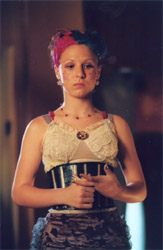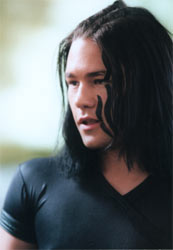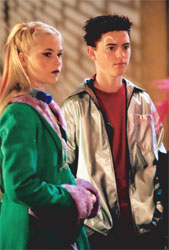 Waking up on the day of a party or a holiday or a hot date is exciting. You either stay in bed as long as you can to hold on to that delicious feeling of anticipation as long as you can or you leap out of bed, eager to get to where you’re heading.
Waking up on the day of a party or a holiday or a hot date is exciting. You either stay in bed as long as you can to hold on to that delicious feeling of anticipation as long as you can or you leap out of bed, eager to get to where you’re heading.
Butterflies in your tummy, your brain speeding along at a thousand miles an hour, you can’t wait to experience what life has to offer you. You look at yourself in the mirror; hardly believing that what is about to happen is going to happen to you.
You see shining eyes staring back at you, excitement welling up in them and waiting to burst out. You stare a little harder, trying to make sure that you look as amazing as you hope you do on a special day like today.
And then you see it. Something ominous. Something red. Something bulgy and ugly. Something that is more vivid than a neon sign on your face. A PIMPLE!!!!
Why do these things happen at crucial stages in our lives? If it’s not just one pimple some of us manage to get a whole face of them. And some of us get them on our chests, back, shoulders, and neck…
What are they?
Pimples are a part of us, literally. Everyone gets them. They pop up when the body reacts in a certain way, most often courtesy of hormonal changes.
There are all sorts of disgusting names for the various blemishes that people can get. And if the names are bad, you should see the pictures!!
There are three main categories of blemish or pimple.
1) Open comedones – these are blackheads that many people get on their noses or chins. They are black not because of dirt but because of a pigment called melanin.
2) Closed comedones – these are whiteheads and are basically a closed, blocked follicle.
3) Nodules – these are generally deeper pimples that start off as uninflamed bumps under the skin until they are squeezed and prodded at. They are generally found on the trunk (the back and chest) and face.
Acne is when there is more than one blemish.
Who gets them?
Hormones are chemicals that are produced in various glands in the body and circulate throughout the bloodstream. They control the actions of organs or cells in the body.
Hormones are always present in our bodies but levels of certain hormones rise when we reach puberty. Levels also rise at other stages of our lives and hormones are affected by stress, medication and other outside factors.
This explains why adults can also be affected and also (but more rarely) some younger children can get them too.
Most people get their spotty days over and done with by the time they are 25 years old though statistics show that around 15% of women and 5% of men still get acne in their adult years.
 So everyone has hormones and everyone can get spots. It depends on how your own hormones play up as to how many spots you are likely to get.
So everyone has hormones and everyone can get spots. It depends on how your own hormones play up as to how many spots you are likely to get.
Other factors include the amount of sebum you produce. Sebum is (in basic terms) the oil that the skin produces and it is there to reduce water loss from the skin and to help fight and protect against bacteria and fungi.
Hormones control the production of sebum so if you have more of a certain hormone you will have more sebum produced and will have more oily skin.
Sebum production changes with age, with illness and with other outside factors.
Outside factors include hygiene issues, dietary issues and environmental issues.
The torture of zits
Having just one zit on the face is enough to make most of us break out in a cold sweat.
We are convinced that everyone we come across in the day is zoning in on the big pustule on the end of our nose and we try anything and everything to cover it up and disguise it.
But some people have more than one zit and this is called acne. This might be a case of a few spots on the chin or the whole face and most of the body being covered in them.
Some of us can deal with this and some can’t. To those that can’t it can become a living torture as they face idiots every day of their lives who pick on them because they are different. They have to deal with name calling like “Pizza face’ or actual physical bullying.
The truth is that none of us are perfect. All of us get spots. And people that only get one or two of them shouldn’t make fun of those who get more of them.
How to make it better
Zits are a part of our life and we have to accept that but there are things that can improve the appearance of the skin and medication that can improve the quality of the skin itself and clear up any zit problems.
 Taking good care of hygiene is important – though just because you have spots or acne doesn’t mean that you are unclean.
Taking good care of hygiene is important – though just because you have spots or acne doesn’t mean that you are unclean.
Everyone is subject to bacteria that cling to the skin. Sometimes due to hormone changes and sebum excretion, bacteria get into the skin and spots develop.
Some people are more prone than others due to their hormones and oily skin.
So, to keep the skin as clean as possible means that the bacteria get washed away.
Once a spot does develop it is really important to leave it alone, no matter how tempting it might be to squeeze it. Every time a zit explodes it releases all the bacteria that it contains and this makes it more likely that another spot develops.
There are various products on the market that are meant to make spots disappear or help to keep them away.
The best thing to do is to talk to your GP or pharmacist or dermatologist to ask what the best product for you to use is. Your health care professional might also think it wise for you to go on medication for a while to help clear the problem up.
Some things that you can do to help your skin on your own is to wash your face thoroughly every morning and evening – never go t bed with a dirty face.
Drink heaps of water – at least 8 glasses a day – this flushes out all the bad stuff from your body.
Keep your hands away from your face! Every day you touch things that aren’t as clean as you would like them to be. Money, door handles, keyboards, etc. all harbour germs and bacteria from other people and if you put your hands on your face you are only passing on more bacteria – yuk!
The cast
Like we said before, everyone gets spots, even the beautiful people from The Tribe!
Some of the cast were prone to spots anyway but after spending 14 hours in heavy make-up in a hot and humid studio doesn’t make for good skin.
Even the cast member with the best skin could count on getting zits when they were filming.
Cast members – male and female – very quickly learnt the importance of good skin care.
 This included good hygiene, drinking HEAPS of water, getting out in the sunshine (not forgetting their sunblock) and eating fresh fruit and veggies.
This included good hygiene, drinking HEAPS of water, getting out in the sunshine (not forgetting their sunblock) and eating fresh fruit and veggies.
And a make-up artist that chased them with a wet flannel!
Pimples in Tribeworld?
Would anyone really care if they got a spot or two in tribeworld? After the Virus hit there was much more to worry about than whether anyone could see the spot on your chin.
Tribes are made up of all sorts of people, big, small, short, and tall. And they are all accepted for who they are, not what they look like.
Sure, Ebony might not have been too chuffed if she got a case of acne before she hooked up with Slade but we’ll bet that she’d be more concerned worrying if she was about to be attacked by Mega.
Just because life has changed dramatically in tribeworld doesn’t mean that the tribes aren’t concerned about what they look like. It just means that they are not preoccupied by it. And they get on with it. They admire and respect all sorts of people and this is not determined by the way they look.
Maybe we should all learn something from that…

